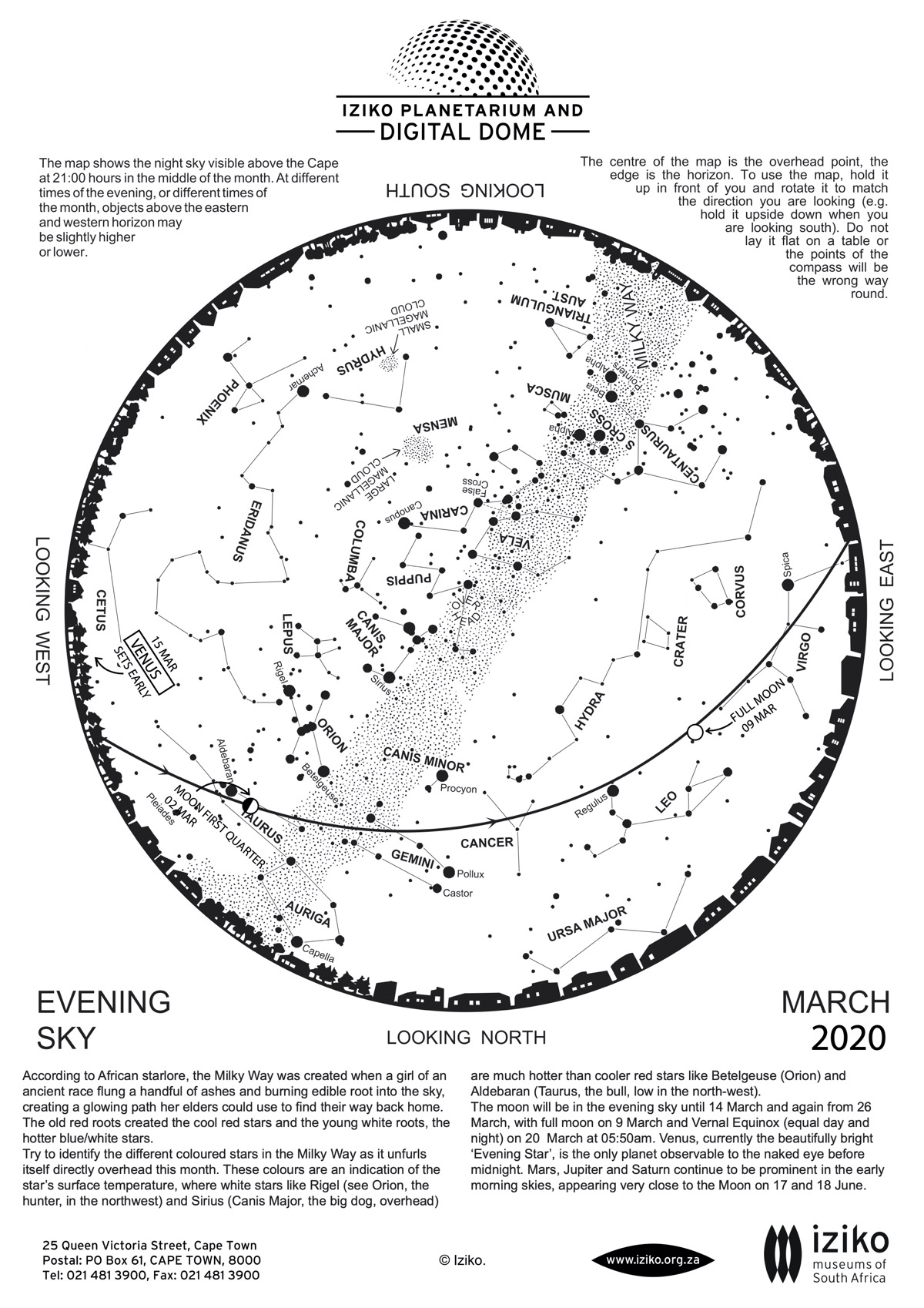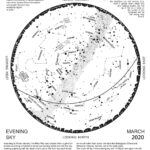
03 Aug Whats Up – August 2020
In a nutshell…
Moon
| Date | Time | Phase |
|---|---|---|
| 03/08 | 17h59 | Full Moon |
| 11/08 | 18h45 | Last Quarter |
| 19/08 | 04h41 | New Moon |
| 25/08 | 18h58 | First Quarter |
Moon – Earth Relations
Perigee: 363 500 km on the 21/08 at 12h59
Apogee: 404 700 km on the 09/08 at 15h51
Planet Visibility
Jupiter and Saturn in Sagittarius visible in the evening sky and at dawn
Mars near Pisces visible at dawn
Venus near Taurus and later near Gemini visible at dawn
Mercury near Gemini visible at dawn at the beginning of the month and in the west in the evening in the last week of the month
Dwarf planets: Ceres reaches opposition on the 28th of August; Pluto near the moon on the 29th of August
Meteors
Piscis Australids: 19th July to the 17th August
Southern delta Aquariids: 21st July to 29th August
alpha Capricornids: 15th July to the 25th August
Some easy to identify bright stars
Antares: red supergiant in Scorpius
Arcturus: red giant in Boötes
Spica: brightest bluish-white star in Virgo
Canopus: yellowish-white star in Carina
Altair: a white star, brightest in Aquila
Regulus: blue–white star and the brightest star in Leo
The Pointers: Alpha and Beta Centauri
Sun and Moon
The Full Moon occurs on 3rd of August at 17h59. The Last Quarter falls on the 11th of August at 18h45. The New Moon is on the 19th of August at 4h41. The First Quarter Moon falls on the 25th of August at 19h58.
On the 2nd of August at 20h06, the moon will be at perigee (closest to Earth) at a distance of 359 397 km. On the 17th of August at 12h51 the moon will be at apogee (furthest from Earth) at a distance of about 406 243 km. The Moon will be at perigee on the 30th of August at a distance of 357 175 km at 17h58.
Planetary and Other Events – Morning and Evening
Jupiter and Saturn, located near the stars of the constellation Sagittarius, are still visible in the evening sky. Both gas giant planets will be near the Moon on the 2nd and the 3rd of August. The Moon will be closer to both Jupiter and Saturn again on the 29th of August. Towards the end of the month, Mercury, the smallest planet in our solar system can be seen in the evening twilight low in the west.
Mars, the red planet, located near the stars of the constellation, Pisces is still visible at dawn. Mars will be near the Moon on the 9th of August. Venus is still dazzling the morning sky and is located near the stars of the constellation, Taurus, at the beginning of the month and near the stars of Gemini towards the end of the month. Venus will be near the moon on the 15th of August. Neptune near the stars of the constellation Aquarius and Uranus near the stars of the constellation Aries, can also be observed at dawn. Neptune will be near the moon on the 6th while Uranus will be located near the moon on the 11th of August.
Ceres, the dwarf planet located between Mars and Jupiter, will reach opposition on the 28th of August and will be well positioned for observation. Pluto will be near the moon on the 29th of August.
After dazzling the northern skies, the Comet Neowise is visible in the southern skies now (though not as bright). It can be observed just after 19h00 just above the north western horizon.
Three meteor showers are active in August: The Piscis Australids, the Southern delta Aquariids and the alpha Capricornids. The Piscis Australids are active from the 19th July to the 17th August, peaking on the 28th July. To view the Piscis Australids find a dark spot and look east near the constellation of Piscis Austrinus for the Piscis Australids radiant. The best time to view the shower is from around 21:30 PM until 05:00 AM when they’ll be in the west. The Southern delta Aquariids meteor shower is active from the 21st July to 29th August, peaking on the 29th July. To view the Southern delta Aquariids, find a dark spot and look east near the constellation of Aquarius for the Southern delta Aquariids radiant. The best time to view the shower is from around 21:30 PM until 05:00 AM when they’ll be in the west. The alpha Capricornids meteor shower is active from the 15th July to the 25th August peaking on the 30th July. To view the shower, look east near the constellation of Capricornus for the alpha Capricornids radiant. The best time to view the alpha Capricornids is from around 20:00 PM until 04:00 AM when they’ll be in the west.
The Evening Sky Stars
In the north, orange Arcturus shines brightly in the evening sky, with the half circle of the Northern Crown to the right, and bright white Vega rising low in the north east. Higher in the ENE, tangled in the northern Milky Way, is Aquila the Eagle with its bright star Altair. Vega and Altair are relatively nearby stars, but like most of the stars visible to the naked eye would appear much brighter than the Sun if they and the Sun were at the same distance.
To the south of Arcturus, high in the NW, shines blue-white Spica, the brightest star in Virgo. Spica actually consists of two stars 260 light years away from us, orbiting each other once every 4 days. Both are much hotter and brighter than the Sun. The brighter of the pair is 11 times as massive as our Sun and 13 000 times as bright, the other 7 times as massive as our sun and ‘only’ 1 700 times as bright.
Red Antares and the stars of the Scorpion are almost overhead in the early evening, and you should easily be able to see the shape of the Scorpion – this is one of the few constellations which really resembles the creature it’s named after. Antares is about 600 light years away, and radiates about 10 000 times as much energy as the Sun at wavelengths perceived by the eye. But Antares has a surface temperature of only 3 300 degrees (compared to 5 500 for the Sun), and radiates most of its energy as infrared radiation. The total energy output of Antares is about 65 000 times as much as the Sun, and this ‘red supergiant’ is so large that if it were placed at the centre of our own solar system, the orbit of Mars would be less than halfway from the centre of Antares to its swollen surface.
High in the south are the Giraffes of Venda star lore (the Pointers – Alpha and Beta Centauri – and the stars of the Southern Cross). For observers away from city lights, the winter Milky Way is spectacular on August evenings when the moon doesn’t interfere. The centre of our Galaxy is nearly overhead, and it is easy to see the ‘pancake’ shape of our wheel of hundreds of billions of suns, complete with the bulge near the middle. For the Indian tribes of South America, the dark patches in the Milky Way were also constellations. We know today that such dark areas as the Coal sack (near the Southern Cross) and the Great Rift are dense dust clouds where new stars are forming.
The Morning Sky Stars
Orion is once again prominent in the eastern sky, raising his club to swat the pesky Bull that forever charges at him. Orion’s two dogs are with him as well, with Procyon (brightest star in the Small Dog) lower in the east and Sirius (brightest star in the Large Dog) to the southeast of Orion. It’s unclear, however, whether the dogs are paying attention to Orion’s problems or to the hare which is hopping by between Orion and the Large Dog.
High in the southeast shines Canopus (called u Canzibe in isi Xhosa), second brightest star in the sky and brightest star in the huge ancient constellation of Argo, the great exploring ship that sought the Golden Fleece. Today it’s split up into several smaller constellations such as the Sails and the Keel. If the Argo is headed to or from Cape Town, it’s only logical that Table Mountain is in view, and it is just possible (on a dark night far from city lights) to see the dim stars of the Table Mountain (Mons Mensae) constellation in the far south. Thanks to Nicolas de Lacaille, who added more than a dozen constellations to the southern sky as he observed from Cape Town, Table Mountain is the only geographical feature on Earth to have its own place in the stars. You’ll probably find it easier to see the Tablecloth, represented by the Large Magellanic Cloud. The LMC, as astronomers know it, is a satellite galaxy of our own Milky Way, and a mere 180 000 light years away. It’s the closest galaxy to our own which is not actually being ‘digested’. Our Milky Way is cannibalizing two small galaxies at the moment, and neither is fully separate anymore. Part of the LMC (which looks to the eye like a stray patch of the Milky Way) slops over into the nearby constellation of the Swordfish, and the remainder of the southern sky is taken up with an odd collection of birds, water creatures and scientific instruments such as the Peacock, the Crane, the Water Snake, and the Rhomboidal Net. The instruments, like Table Mountain, owe their place in the sky to Lacaille’s mapping of the southern sky in the mid-eighteenth century.
Flowing from the southwest corner of Orion is the long winding constellation of Eridanus the celestial river, with bright Achernar near its ‘mouth’ high in the southwest. Canopus is ‘Naka’ (the ‘Horn’ star), in the Sotho calendar, while Achernar is ‘Senakane’, the ‘little horn’. To the west of Eridanus is a rather watery part of the sky including the Whale, the Fishes, the Water Bearer and the Sea Goat. Fomalhaut (meaning ‘mouth of the southern fish’) is the brightest star in the western sky, but almost all the bright stars in this month’s morning sky are in the east. It’s relatively nearby (only 25 light years away) and a mere 200 million years old, making it just a baby compared to the Sun. A huge disk of icy dust, four times the diameter of our solar system, surrounds Fomalhaut. There is a clear area around the star itself which may have been caused by the formation of a system of planets, but the actual planets elude detection so far. It’s quite likely that there are planets.
The evening sky over Cape Town
The evening sky over Johannesburg


